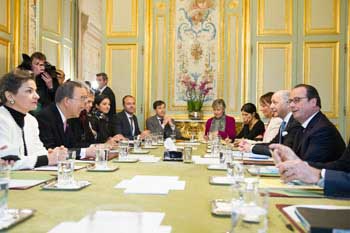195 countries. 40,000 attendants. 12 days to achieve a goal: reaching a global deal to avoid a higher than 2 ºC warming by the end of century compared to the preindustrial era. These are the most relevant figures in the twenty-first Conference of the Parties, which started this monday in Paris.
The future of the planet and all its inhabitants can improve depending on the agreement resulting from the negotiations in Paris. Until Friday the 11th, the last day of the meeting, governments will try to reach an agreement to stop global warming and replace the Kyoto Protocol, which expires in 2020.
The COP21 gathers together in Le Bourget, just outside the French capital, political leaders, representatives of the private sector, NGOs, activist and civil society, and has the crucial task of closing a universal pact to reduce emissions of greenhouse emissions (GHG) and limit global warming.
Will COP21 make any difference?

Although only time will tell whether this Conference of the Parties went as expected, the fact is that experts say there are reasons to be more optimistic than in the past. The main difference from other summits is that in this COP21 almost every country come to negotiations with national plans for reducing emissions. That is, they all share a responsibility to combat climate change even though the commitments vary in each country.
It is not the first time that expectations are very high. During COP15 in Copenhagen experts thought that an agreement that would compromise all countries was close, but no deal was reached and it was the first big disappointment. This time, all countries have involved showing their concerns in the final draft that is being negotiated during the Paris summit.
Do all the countries have the same importance at COP21?
The responsibilities on climate change are common but differentiated. Out of the 195 countries participating in the summit -the European Union represents its 28 countries-, the spotlight always focuses on those with greater economic, political and industrial weight.
First, China's role is critical as they are first emitter of greenhouse gases and are exposed to climate risks (particularly floods). For this reason, Beijing has been one of the most active agents in promoting a global agreement, but with conditions: they agree to revisit alliances before 2020, the year when measures entry into force, but they won't subscribe upward revisions every five years.
For its part, the United States (second largest emitter) has a great dilemma. Obama has shown a willingness to adapt environmental measures (plan to reduce emissions of coal power plants, opposition to the proposed giant pipeline between the United States and Canada) but has not yet found a way of compromising national economic objectives as he faces a congress of Republican majority.

At the other end of the scale we found the most disadvantaged countries and small island nations, among others. Historically, these poor nations also suffer pollution from greenhouse gases and are more damaged by the effects of climate change as they are more vulnerable. Lack of infrastructure,
inability to respond to emergencies, vulnerable to natural phenomena ... To overcome these disadvantages, the UN has proposed a periodic financial to promote the best possible adaptation of these countries in the future.
Do you think countries will actually fight against global warming after COP21? Share your opinion and participate in our poll.
Sources: COP21 Paris, El País, El Confidencial, El País II, La Marea, Ecoticias, Radio Francia Internacional and El Comercio.